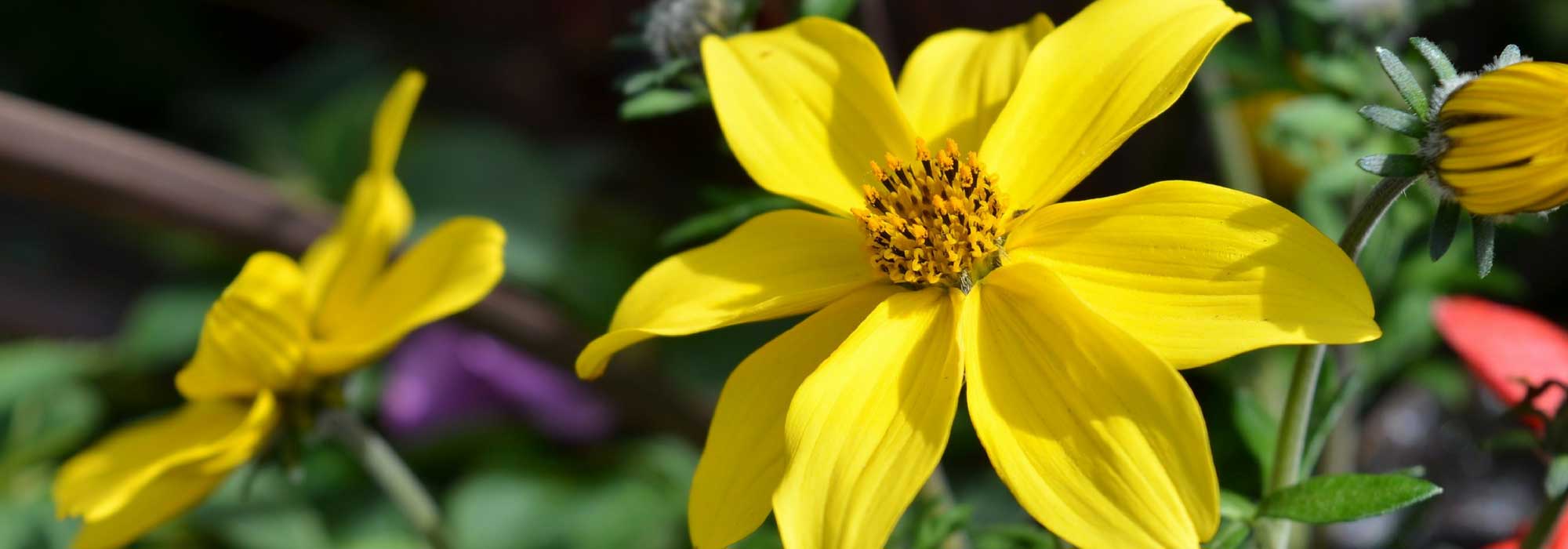
Bidens: planting, growing and care
Contents
Bidens in a nutshell
- Bidens is an essential annual flower for summer containers and hanging baskets
- It grows very quickly and is highly floriferous
- Yellow, orange, pink, or white Bidens flowers, shaped like small stars, renew from June to October without interruption
- Low in water requirements and needing little maintenance, it thrives in full sun and well-drained soil
- Forming a spreading cushion or a trailing cascade, it is unmatched for brightening up borders and rockeries with ease
A word from our expert
With its flowering that alternates between sunny and pastel shades, the bidens ferulifolia is the essential plant for your hanging baskets, window boxes, and pots!
Delicately trailing with its long, flexible stems bearing finely cut foliage, the bidens is also an excellent ground cover for slopes or the edges of sunny borders. This hardy perennial, cultivated here as an annual, is valued for its generous, continuous flowering from May until the first frosts and its rapid growth.
A shower of golden stars with yellow bidens, a flamboyant bicolour display with red-orange bidens, a romantic touch with the white bidens ‘Pirate’s Pearl’ or the pink bidens ‘Spotlight’, this easy-to-pair annual flower is perfect for adding colour and cheer to a garden, terrace, or balcony throughout the beautiful season, with minimal maintenance.
The Bidens is sun-loving and thrives in well-drained, not too dry soil.
Choose without delay your bidens from our collection of plug plants of annual flowers and ensure abundant blooms in hanging baskets, window boxes, and borders for over six months of the year!
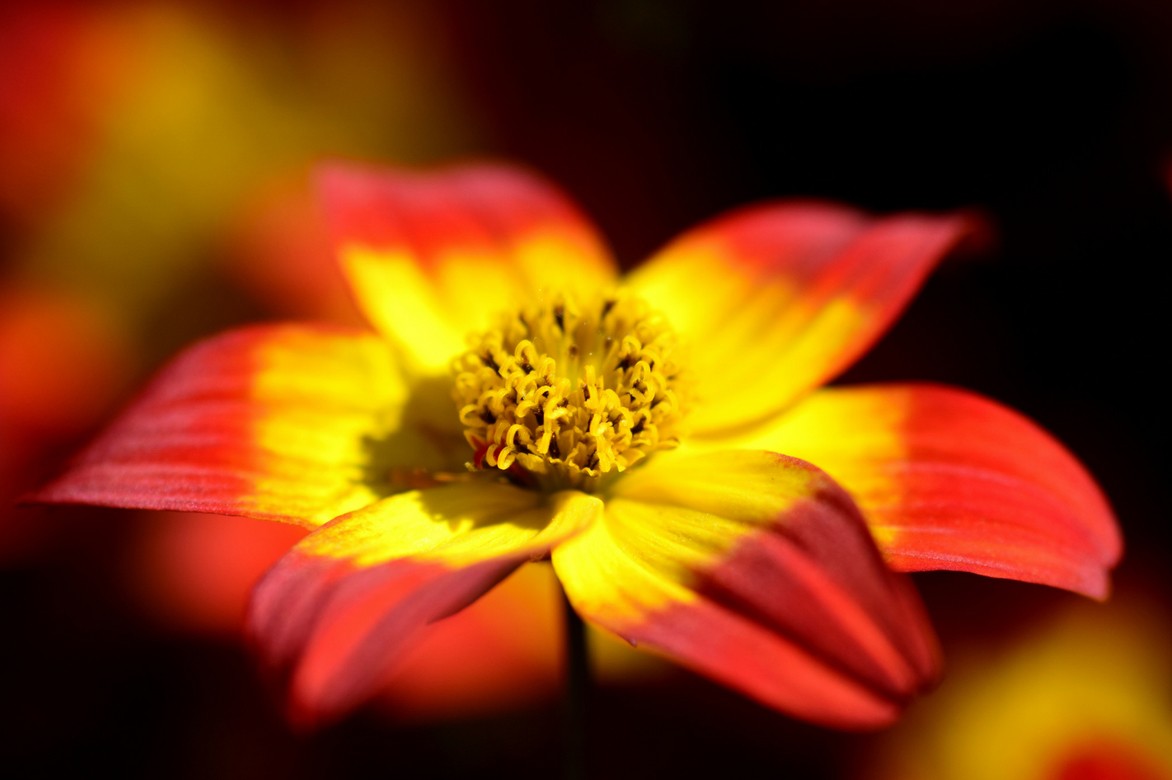
Close-up of a flower of Bidens.
Description and botany
Botanical data
- Latin name Bidens
- Family Asteraceae
- Common name Bidens, beggar's ticks
- Flowering from May to autumn
- Height 0.20 to 60 cm
- Exposure Sun
- Soil type All, well-drained
- Hardiness not very hardy, -5°C
The Bidens is a perennial plant from the Asteraceae family, native to the meadows, slopes, and thickets of the tropical regions of Africa and America. Of the 240 species of annuals, perennials, and deciduous bushes generally grown as annuals in our climates due to their sensitivity to cold, bidens ferulifolia or the fern-leaved bidens is the most cultivated. It comes in many varieties, larger, more floriferous, and more compact, improving the typical species with its characteristic golden yellow flowering, such as ‘Yellow Charm’ and ‘Pirate’s Pearl’ with white flowers.
New lines of hybrid plants selected for their endless flowering and very compact habit have also emerged, featuring vibrant and bicolour shades of orange and red, like the Beedance® series and B. triplinervia ‘Hawaian Flare’.
The Bidens is a fast-growing plant but has a short lifespan. It quickly forms beautiful bushy clumps, with a more or less compact and spreading habit, often trailing. It creates a lovely cushion that is generally quite low but voluminous, rarely exceeding 60 cm in height. It consists of branched and leafy stems radiating from its base in all directions. Wider than tall, it tends to spread impressively at times.
On long, flexible stems, a fine evergreen foliage develops, especially in very mild winters (or if grown in pots), delicately and deeply cut into small, very narrow divided leaves. As it spreads, it adds a certain lushness to the plant. Rarely elegant and highly divided, it evokes the lightness of some ferns. The opposite leaves, simple or pinnate with lanceolate leaflets, upright or spreading, measure 8 to 10 cm long and are a bright fresh green to dark green.

Several colours of Bidens: Bidens ‘Fairy Light’, Bidens ‘Pirate’s Pearl’, Bidens ‘Lemon Moon’, Bidens ‘Campfire Fireburst’.
This vigorous and compact vegetation serves as a backdrop for the abundant and radiant flowering. In the heart of spring, from May onwards and until the first frosts, a shower of small daisies with golden centres covers this refined foliage. The slender stems bear terminal inflorescences in heads measuring 3 to 7 cm in diameter.
Like small sunflowers, they are suspended by thin peduncles and consist of 5 to 8 petals arranged around a golden yellow centre that turns brownish at maturity. The structure of the flowers and the colour of the ligules vary according to the cultivars. Some, like Bidens ‘Spotlight’, produce small heads that resemble miniature dahlias. Some varieties are characterised by more or less double flowers.
While the typical species Bidens ferulifolia and many of its cultivars bear bright golden yellow flowers, recent lines of hybrid plants (series B. triplinervia ‘Hawaian Flare) showcase new vibrant and sometimes bicolour shades in very warm tones from orange to red, such as Bidens ‘Painted Red’ and ‘Campfire Fireburst’. Others have pure white ligules like Bidens ferulifolia ‘Pirate’s Pearl’, resembling a classic daisy, or heads of golden yellow broadly edged with cream white (Bidens ‘Lemon Moon’).
The plant is tireless, flowering for more than six months of the year! This flowering is particularly melliferous, emitting a light honey scent.

Bidens flowers are highly sought after by pollinating insects.
The Bidens is grown in our country as an annual in open ground due to its low hardiness (-5°C) against frost. If you want to keep this frost-sensitive plant, bring it indoors before the first cold weather into a well-lit, frost-free room. The bidens is an easy plant that enjoys sunny exposure and withstands drought and heat well. Very floriferous, it requires light, fertile soil, not too calcareous, fresh, and especially well-drained.
The Bidens thrives in summer beds, as ground cover in rockeries, and particularly in hanging baskets and flowering pots.
Main species and varieties
The bidens ferulifolia is the most commonly grown in our gardens. It is now available in numerous varieties and cultivars with the characteristic golden yellow flowering of the Bidens, but offers a choice of varied colours such as ‘Pirate’s Pearl’ with white flowers. These new varieties have a more compact habit and an earlier flowering.
Hybrids selected for their endless flowering and very sturdy habit are also available in vibrant and bicoloured orange and red tones like the cultivars from the Beedance® series.
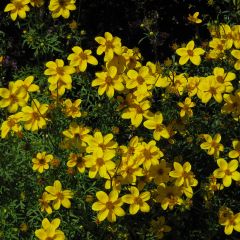
Bidens Yellow Charm
- Flowering time July to November
- Height at maturity 30 cm
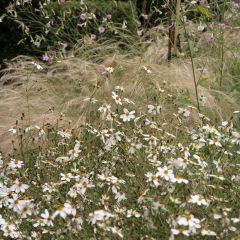
Bidens Pirates Pearl
- Flowering time July to November
- Height at maturity 80 cm
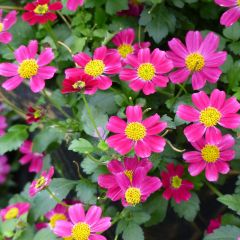
Bidens Stoplight
- Flowering time June to November
- Height at maturity 20 cm
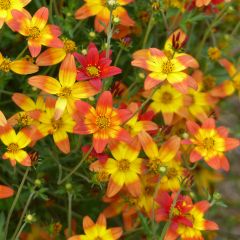
Bidens Campfire Fireburst
- Flowering time July to October
- Height at maturity 25 cm
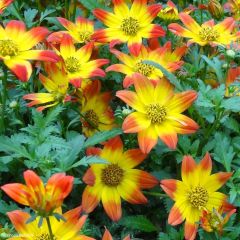
Bidens Beedance Painted Red
- Flowering time July to November
- Height at maturity 25 cm
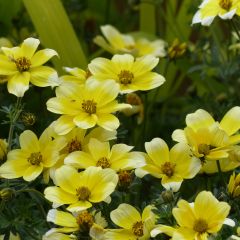
Bidens Lemon Moon
- Flowering time June to November
- Height at maturity 30 cm
Discover other Bidens
View all →Available in 1 sizes
Available in 1 sizes
Available in 1 sizes
Available in 1 sizes
Available in 1 sizes
Available in 1 sizes
Available in 1 sizes
Available in 1 sizes
Available in 2 sizes
Available in 1 sizes
Planting
Where to Plant Bidens?
From its tropical origins, Bidens has retained a high sensitivity to cold. It is a frost-sensitive plant that, although it tolerates a light and brief late frost, disappears below 5°C. When grown in soil, Bidens struggles to survive our winters at these latitudes. This is why, in our climates, it is cultivated as an annual in the garden or placed in pots to be brought indoors before the first frosts, in a bright and heated location where the temperature does not drop below -10°C to preserve its delicate foliage.
Bidens is also a staple for pot cultivation. Sheltered from frost, potted Bidens bloom continuously from April to January. You can bring it out during the beautiful season.
Bidens needs full sun to ensure abundant flowering. Once well established, it is quite drought-tolerant and can withstand brief heat spells.
Not very demanding, Bidens adapts to all types of soil as long as it is well-drained. However, in fertile and cool soil, its growth will be greatly enhanced, and its flowering will be very abundant, especially in pots.
In the garden, it tends to spread, risking becoming invasive for a season: give it enough space to thrive comfortably.
Its endless flowering from May to the first frosts makes it an excellent choice for quickly brightening up sunny summer flower beds, beautiful pots, window boxes, or hanging baskets to place on your window sills, balconies, or terraces exposed to the sun (which can be kept warm in the conservatory during winter).
With its compact habit and limited size, it also makes an excellent bright ground cover for slopes. It can even climb a wire fence, where its long, flexible stems will eventually latch on and climb by themselves.
When to Plant Bidens?
Plant Bidens in spring, in April or May depending on the region, when the risk of frost has definitely passed. There is nothing stopping you from pre-growing them in pots in a warm and bright location before their final placement in well-warmed soil.
How to Plant Bidens?
In Open Ground
Bidens prefers fertile and well-drained soils. In spring, in April-May, as soon as the risk of frost is no longer a concern, plant them in open ground.
Plant closely, 30 to 40 cm apart, at a rate of 4 to 5 buckets per m² if you want to achieve a denser and more profuse effect quickly.
- Loosen the soil well to remove weeds, stones, and roots
- Dig a hole three times wider than the root ball
- Add sand to heavy soil to ensure good drainage
- Add well-decomposed compost
- Create a good bed of gravel or clay balls
- Place the root ball in the centre of the hole, with the collar level with the soil
- Cover with soil
- Firm down with your foot and mulch
- Water immediately after planting and then very regularly: Bidens likes soil to remain moist
Planting Bidens in pots or hanging baskets
The Bidens is a must for pot cultivation. Plant one young plant per small diameter pot, and at least 3 to 4 buckets for larger planters, and place it in full sun. To create a mixed planter, you can plant it directly with the pot, which will limit its spread: it tends to smother its neighbours!
- Plant in a good potting mix for flowering plants, mixed with sand or perlite to lighten the substrate
- Add a bit of compost or slow-release fertiliser
- Mulch the base to keep it cool throughout the summer
- Water generously, keeping the substrate slightly moist at all times
- Fertilise regularly
- In autumn, bring the pots in to protect them from frost
→ Read also: Growing Bidens in Pots for Vibrant Flowers.
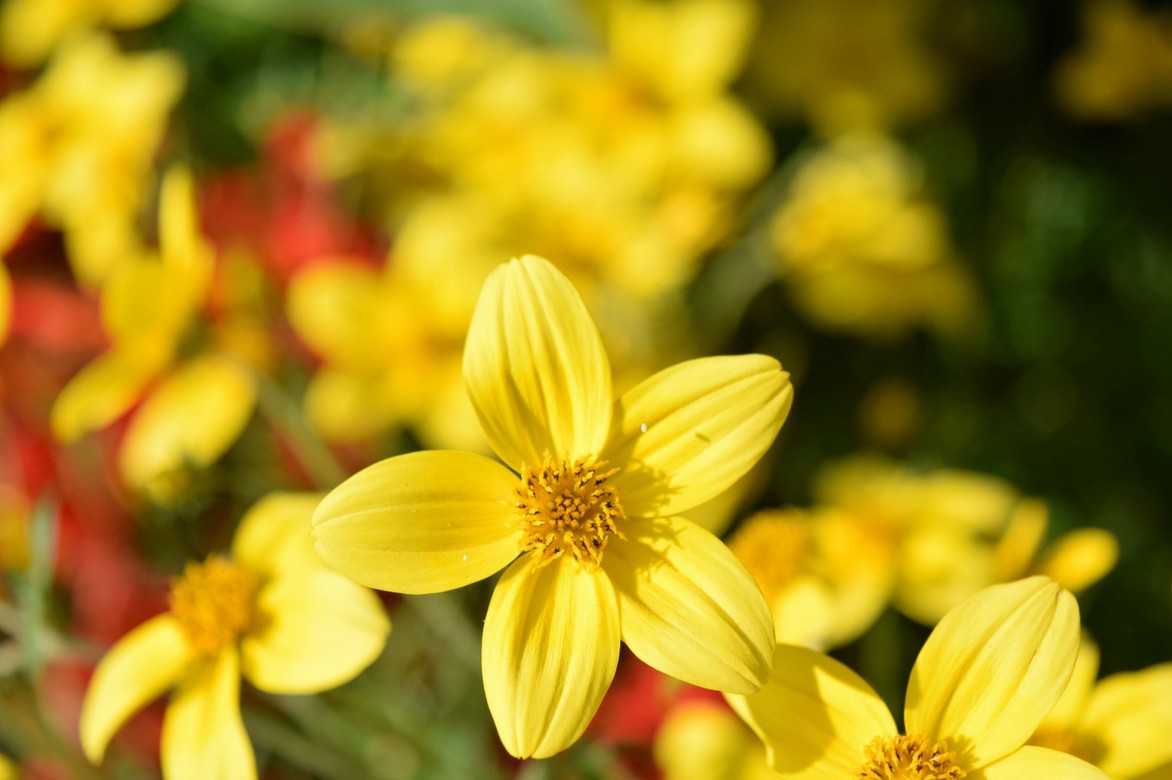
Yellow Bidens Flowers
When and how to sow Bidens?
Sow preferably under cover in trays from the beginning of spring in February-March at a temperature between 13 and 18°C.
How to sow Bidens seeds
- Sow the seeds, covering them lightly with compost kept slightly moist but never waterlogged
- Place the sowing during the germination period (germination occurs between 10 and 21 days). When the seedlings are large enough, at the stage of three true leaves, separate them and transplant into individual buckets, keeping them a little warm
- Pinch (cut with fingers) the tips of the stems to encourage them to branch
- In May, as soon as the risk of frost has passed, transplant the young plants into window boxes, pots, or directly into the ground.
Maintenance and Care of Bidens
It is a truly easy-to-cultivate ephemeral perennial, low-maintenance whose care is kept to a minimum. As long as this greedy flower does not lack food, water, or sunlight, as this tender plant needs warmth!
Even though it tolerates short periods of drought fairly well, bidens prefers soils that remain cool: as soon as dry weather sets in, whether in pots or borders, it must be watered regularly during hot weather, especially if it does not rain. Conversely, it rots in heavy, poorly drained soil that is constantly waterlogged. Mulch in May to ensure the base remains sufficiently cool in summer.
Regularly remove faded flowers to encourage the appearance of new ones and pinch the tips of the stems occasionally to achieve a more compact and ramified habit: once pinched, it spreads!
Not very hardy, Bidens only tolerates very light frosts. You must bring it indoors before the first cold (in a bright room that does not drop below 5°C) if you wish to preserve its beautiful foliage and extend its lovely flowering throughout the winter.
In cold climates, pull up the plant when the foliage is wilted, burned by the first frosts. In a region with a mild climate, simply clean the foliage at the end of autumn; it will remain green and persist during a mild winter.
Diseases and potential pests
The Bidens has no enemies; it is resistant to diseases and parasitic threats.
Multiplication: propagating the bidens
Multiplying bidens by sowing is more delicate; we recommend propagation by cuttings instead.
How to take cuttings of Bidens?
- In May, take 20 cm long, flowerless stems with a sharp cut
- Remove the lower leaves
- Replant in pots or trays filled with potting soil and sand, and water regularly
- Place in a heated shelter
- Replant in open ground or in a planter when they have sufficiently hardened, once the soil is well warmed and all risk of frost has passed
Pairing Bidens
The Bidens is essential for creating vibrant or romantic summer scenes. With its naïve and sunny flowers, the Bidens is perfect for illuminating natural-looking scenes with simplicity.
In naturalistic mixed borders, the Bidens happily mingles with other daisy-flowered annuals or perennials.
With its bushy and trailing habit, the Bidens is invaluable in borders, in hanging baskets, or to create compact masses in the foreground of flower beds to add volume and abundance. The yellow-gold, orange-red, or white flowers of Bidens bring plenty of brightness during the summer season and allow for numerous colour combinations.
In a planter, the Bidens cohabits happily with other annuals such as Lobelias and diascia. Alyssum and bacopa will cover the base of the Bidens.
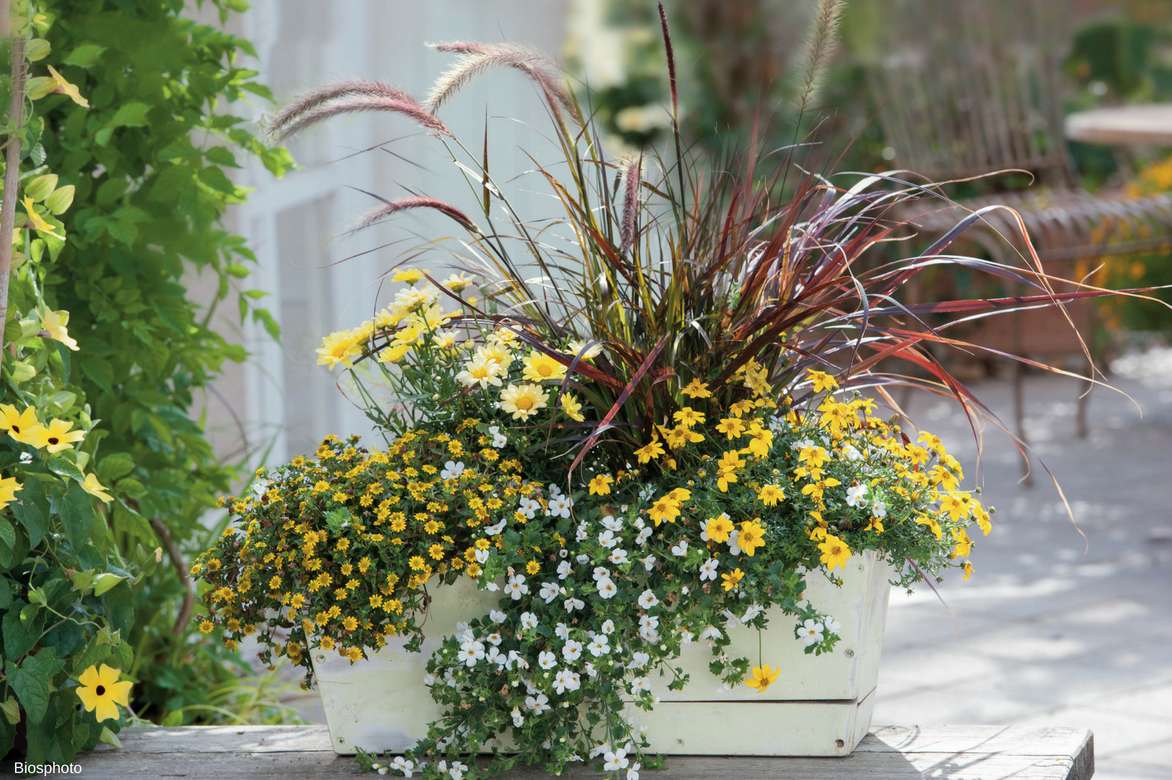
An example of a planter association: Sanvitalia procumbens ‘Aztekengold’, Anthemis ‘Butterfly Yellow’, Pennisetum setaceum ‘Rubrum’, Bacopa ‘Gulliver Dynamic White’ and Bidens ‘Yellow Charm’.
Varieties with vibrant and bicoloured flowers like Bidens ‘Campfire Firebust’ pair wonderfully with red balcony geraniums, surfinia, supertunias, or ‘Million bells’ petunias.
Create blue/yellow or yellow/red colour contrasts by placing Bidens flowers next to purple annual Lobelias, Zinnias, dark blue Surfinias, blue salvias, and red Begonias.
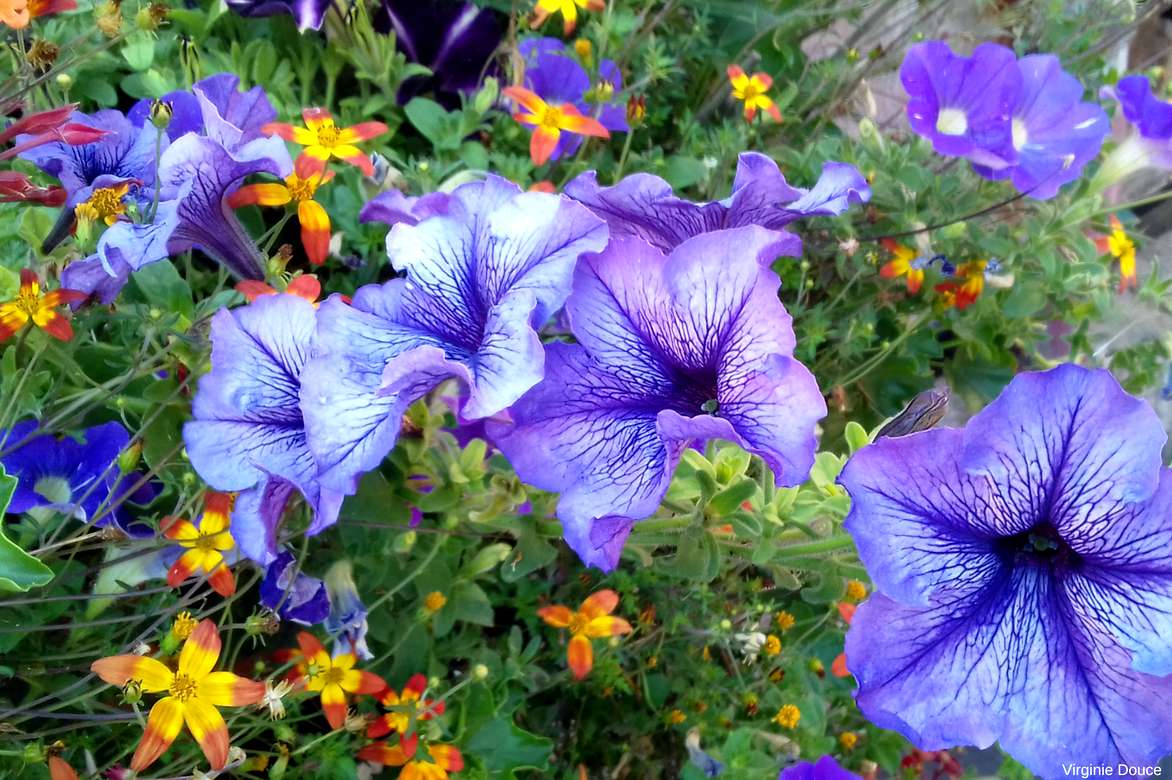
An example of a contrasting association: Bidens ‘Campfire Fireburst’ and a Petunia.
The Bidens forms flowering cushions that will delicately dress the base of a shrub rose or a Caryopteris.
In a border, its elegantly cut, very dense green foliage provides a backdrop for slightly taller summer flowers, such as cosmos, red or blue verbenas, and is perfect for playing with foliage effects that bring a lot of lightness with Helichrysum.
In the foreground of a flower bed, it can be paired with warm-coloured flowers and foliage like coleus, contrasting hardy herbaceous plants like yarrow, and salvias.
In a homogeneous and vibrant association of daisies, Bidens will unify the whole by weaving between its annual cousins, Anthemis, Osteospermum, and Rudbeckia.
Its habit allows it to beautifully intertwine with other plants, cascading over the edge of a pot or hanging basket alongside other creeping plants like cultivars of Speedwell (Anagallis monellii) and Peruvian Heliotrope.
Useful resources
- Make your summer easier by creating low-maintenance flower beds!
- Discover all of our annual flowers in plug plants
- To accompany your bidens, choose from our beautiful collection of daisy-type annuals
- Subscribe!
- Contents
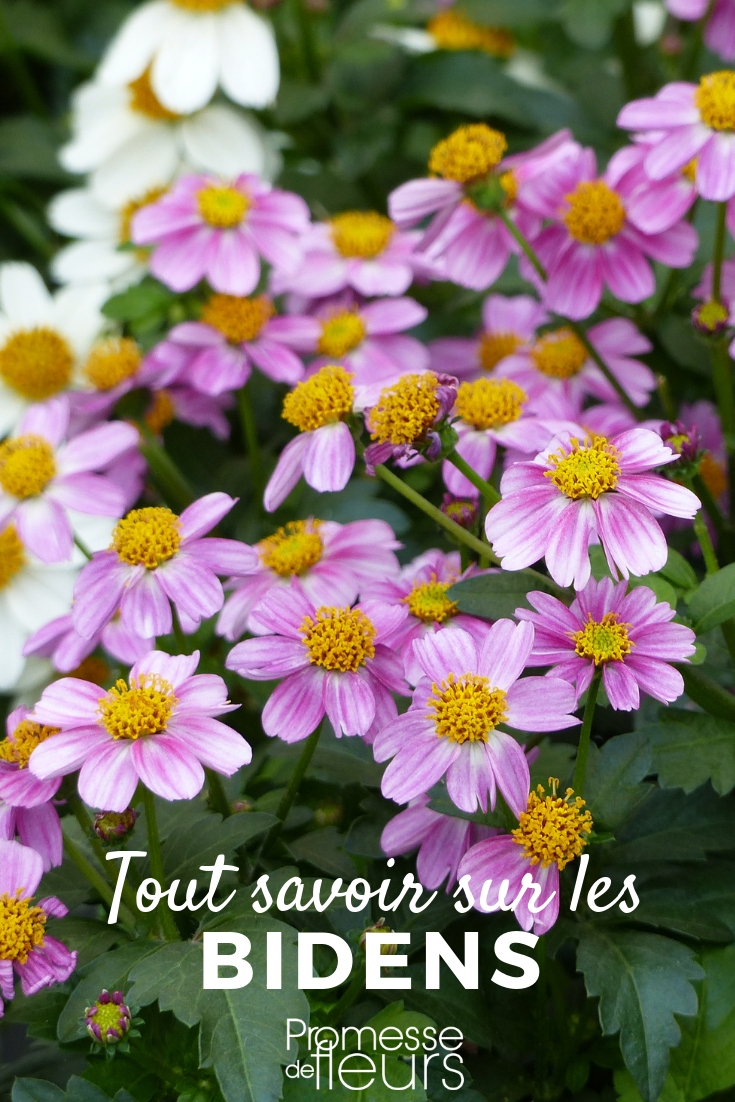


































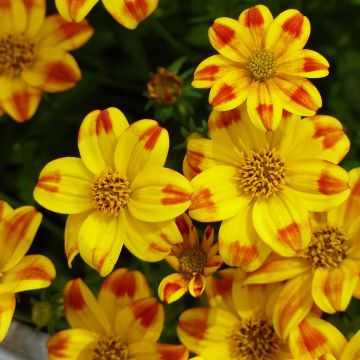


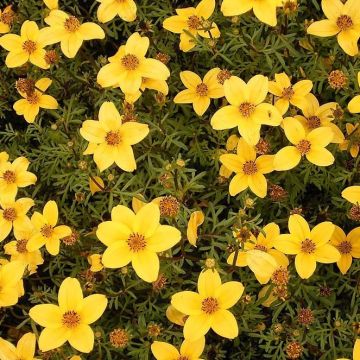
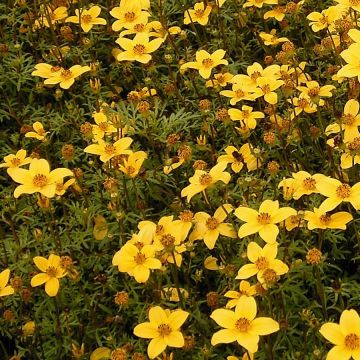

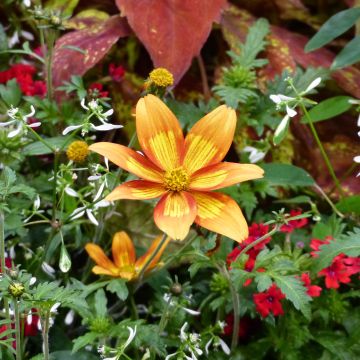
Comments